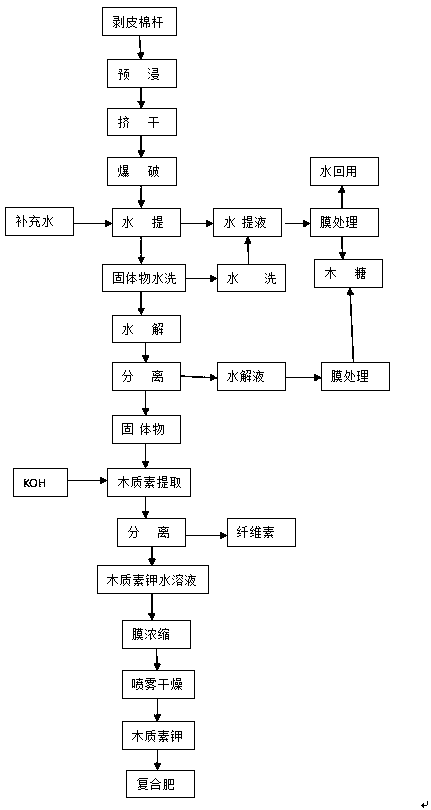Method for separating cellulose, hemicellulose and lignin in cotton stalk
A technology of hemicellulose and separation method, which is applied in the direction of raw material separation, non-woody plant/crop pulp, pulp dehydration, etc., can solve the problems of long production cycle and unfavorable industrial production, and achieve high conversion rate, safe operation and process simple effect
- Summary
- Abstract
- Description
- Claims
- Application Information
AI Technical Summary
Problems solved by technology
Method used
Image
Examples
Embodiment 1
[0029] The method for separating and fully utilizing cellulose, hemicellulose and lignin in cotton stalks comprises the following steps:
[0030] (1) Pretreatment: After the collected cotton stalks are separated, they are cut into lengths of 8-12cm. After screening, they enter a continuous presoaker for presoaking with an aqueous solution containing dilute sulfuric acid with a mass concentration of 0.4%. The ratio is 1:6. The presoaking temperature is normal temperature and the time is 6h.
[0031] (2) Squeeze dry: dehydrate the material after soaking in the continuous prepreg machine to make the water content 40%;
[0032] (3) Steam explosion treatment: Put the dehydrated cotton stalks into the steam explosion device for steam explosion treatment; when steam explosion treatment, first pressurize with steam to 2.0MPa, then pressurize with compressed air to 3.5MPa, and keep for 120s , to achieve instant explosion.
[0033] (4) Water washing to extract xylose: extract xylose ...
Embodiment 2
[0040] The method for separating and fully utilizing cellulose, hemicellulose and lignin in cotton stalks comprises the following steps:
[0041] (1) Pretreatment: After the collected cotton stalks are separated, they are cut into lengths of 8-12cm. After screening, they are put into a continuous presoaker and presoaked with an aqueous solution containing 0.4%% dilute sulfuric acid. The solid-to-liquid ratio is 1: 6.
[0042] (2) Squeeze dry: dehydrate the material after soaking in the continuous prepreg machine to make the water content 40%;
[0043] (3) Steam explosion treatment: Put the dehydrated cotton stalks into the steam explosion device for steam explosion treatment; when steam explosion treatment, first pressurize with steam to 2.0MPa, then pressurize with compressed air to 3.5MPa, and keep for 120s , burst instantly.
[0044] (4) Water washing to extract xylose: extract xylose from the material after gas explosion, the mass ratio of material to water is 1:10, the ...
Embodiment 3
[0051] The method for separating and fully utilizing cellulose, hemicellulose and lignin in cotton stalks comprises the following steps:
[0052] (1) Pretreatment: After the collected cotton stalks are separated, they are cut into lengths of 8-12cm. After screening, they are put into a continuous presoaker and presoaked with an aqueous solution containing 0.4%% dilute sulfuric acid. The solid-to-liquid ratio is 1: 6.
[0053] (2) Squeeze dry: dehydrate the material after soaking in the continuous prepreg machine to make the water content 40%;
[0054] (3) Steam explosion treatment: Put the dehydrated cotton stalks into the steam explosion device for steam explosion treatment; during steam explosion treatment, first pressurize to 2.0MPa with steam, then pressurize to 5MPa with compressed air, and keep it for 120s. It exploded instantly.
[0055] (4) Water washing to extract xylose: extract xylose from the material after gas explosion, the mass ratio of material to water is 1:...
PUM
| Property | Measurement | Unit |
|---|---|---|
| degree of polymerization | aaaaa | aaaaa |
Abstract
Description
Claims
Application Information
 Login to View More
Login to View More - R&D
- Intellectual Property
- Life Sciences
- Materials
- Tech Scout
- Unparalleled Data Quality
- Higher Quality Content
- 60% Fewer Hallucinations
Browse by: Latest US Patents, China's latest patents, Technical Efficacy Thesaurus, Application Domain, Technology Topic, Popular Technical Reports.
© 2025 PatSnap. All rights reserved.Legal|Privacy policy|Modern Slavery Act Transparency Statement|Sitemap|About US| Contact US: help@patsnap.com

